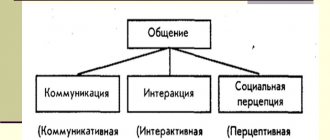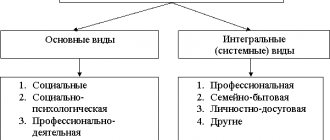J. Piaget, speaking about general trends in the development of children's language abilities, expressed the idea that first the child develops “speech for himself”, and then, under pressure from adults, the formation of specialized “speech for others” occurs. But the Russian psychologist Vygotsky believes the opposite - the development of a child’s speech occurs from thinking out loud to thinking for oneself. Thus, the diverse speech of a person has different forms.
In the development of speech function, there is a distinction between sensory speech or understanding, which appears in the child in the second half of the year, and expressive speech, i.e. ability to speak. From the point of view of signal meaning, the development of expressive speech proceeds in parallel. In the second half of life, the baby’s babble already clearly approaches the sounds of speech; before this, children of all nationalities walk in exactly the same way.
Are you an expert in this subject area? We invite you to become the author of the Directory Working Conditions
Experts distinguish types of speech from the point of view of its genesis and other mental processes. In this regard, we can talk about a whole chain of closely interconnected stages of speech formation:
- External speech addressed to the subject when establishing communication;
- External speech that does not have a specific subject, but presupposes it. In principle, it is not addressed to anyone;
- Whispered speech turning into muttering;
- Inner speech - “pronunciation to oneself” of a complete phrase while maintaining the full verbal content and syntactic form;
- Condensed inner speech is shorter in duration and retains its meaning. Such “compressed” speech can be represented as a thinking process.
Psychologists distinguish between two types of speech: external and internal.
Types of speech. External speech
There are two types of speech: external and internal. External speech is addressed to other people.
Through it, a person transmits and perceives thoughts. Inner speech is speech “to oneself”, speech in the form of which a person thinks. Both types of speech are mutually related. External speech, in turn, is divided into two types: oral and written. Each of these types of external speech has its own psychological characteristics that need to be known in order to correctly use them in the communication process.
Functions of speech
There are 4 main functions of speech:
- Communicative . Associated with communication between people and the transfer of information. It has internal divisions shown below.
- Cognitive. It is the main mechanism for accumulating human knowledge and transferring it to new generations.
- Psychodiagnostic . By observing the speaking process, the interlocutor understands the state of the speaker and can create a portrait of his personality.
- Psychotherapeutic. Involves the ability to verbally support another person.
The communicative function has 4 aspects (what is it?):
- Organizational . Conversation is used to agree on common actions.
- Expressive. An antisocial state and reaction are expressed and emphasis is placed.
- Incentive . Implies a request, order, persuasion.
- Marking . A person’s characterization of everything that surrounds him, for orientation in space, for the transfer of experience or his assessment to others.
Oral speech
Oral speech is speech addressed directly to someone. It is expressed in sounds and is perceived by other people through hearing. Oral speech is the most ancient in origin. Children also learn oral speech first, and then written speech. Oral speech manifests itself in monologue and dialogic forms.
Dialogical speech means a conversation between two or more persons who either listen when others speak, or speak when they are listened to. The one who is speaking at the moment is an active person, and the one who listens is passive in relation to the speaker.
However, passivity in dialogue is relative, since the perception of speech is an active process, sometimes requiring far from easy mental activity from the listener. In the process of verbal communication, the interlocutors change roles and support each other in conversation, which is why dialogical speech is sometimes called supported speech. Exchange of roles allows interlocutors to better understand each other.
A characteristic feature of dialogical speech is direct communication: the interlocutors hear and most often see each other. This circumstance allows speakers to use expressive means of language: voice intonation, facial expressions, gestures.
At the same time, the speaker can observe (in conditions of mutual vision) the reactions of listeners to his speech, attention or inattention to it, the degree of understanding, agreement or disagreement, etc. These observations allow the speaker to adjust his speech, repeat some thoughts, expand or, conversely, curtail reasoning, strengthen or weaken expressive means of speech.
Thus, a teacher conducting a conversation with students in a lesson not only directs the children’s thoughts and statements with his questions, but also constantly changes the nature of his speech depending on the students’ reaction to it.
Dialogue speech
Dialogical speech occurs in specific conditions, and the subject of the conversation is familiar to the interlocutors. This allows them, in some cases, to understand each other perfectly. Therefore, in a free dialogue (in a normal conversation between two or more people), the interlocutors do not always adhere to language rules, shorten sentences, and supplement what is said with facial expressions, gestures, and unique intonations.
Monologue speech
Monologue speech is the speech of one person. He speaks and others listen. This type of speech includes various speeches by one person before an audience: a lecture, a report, a message, a deputy’s speech, an actor’s monologue, etc. A monologue is a speech that is continuous and unsupported by listeners.
In this sense, it is more difficult than dialogue. Before speaking, the speaker must think through the content of the speech, the plan for presenting thoughts, the form of presentation, taking into account the audience, its preparation, experience and knowledge. He assumes in advance that it may turn out to be complex and unclear, what questions the listeners may have, and how they will react to his speech.
All this gives the author a feeling of high responsibility for the content, form and composition of the speech. Monologue speech requires compliance with the laws of logic and the rules of grammar. The power of its influence is achieved by the persuasiveness of evidence (scientific and business speech), imagery and expressiveness, and influence on the feelings of listeners (speech of a speaker, artist).
The teacher's speech should contain all these means. Monologue speech requires not only mandatory preliminary preparation, but also continuous attention to one’s own speech (its content, persuasiveness, linguistic perfection, etc.) and to the reactions of listeners. In other words, monologue speech requires the speaker to have a high culture of thinking, speech and psychological observation.
A monologue is difficult not only for the speaker, but also for the listeners, whose attention must be stable and focused for a long time. The perception of monologue speech is especially difficult for children, and the younger they are, the more so. The reason for this is not only the lack of stability of children’s attention, but also the uniqueness of the object of attention: attention to words, to the content of speech, and even more so to the sequence of the speaker’s reasoning is always more difficult than attention to real things and phenomena.
Monologue speech in its structure is closer to written speech than dialogical speech.
Written speech
Written speech is expressed by graphic signs and is perceived by sight. It is a type of speech with which communication between people separated by long distances and time is possible. Psychological analysis of written speech shows that it is more difficult than oral speech, both for those who convey thoughts through it, and for those who perceive these thoughts.
The writer conveys the content of speech without using such auxiliary means of language as intonation, facial expressions, and gestures, which facilitate the understanding of thoughts. The writer cannot always take into account the reaction of readers to his speech, because he does not see, does not hear, and often does not know them.
The circle of readers of books, newspapers, and magazines is very wide and diverse. Readers are also deprived of the opportunity to directly express their opinion about the content and form of what is written. To become accessible to a wide range of readers, written speech must be structured as detailed, fully consistent with the rules of logic and grammar.
Written speech places great demands on the person who uses it. Written speech can be dialogical and monological.
Inner speech is speech “to oneself”, with the help of which logical processing of sensory data occurs, their awareness and understanding in a certain system of concepts and judgments. A person does not directly address other people with it, but through it a thought is formed and exists.
Inner speech is difficult to study, so psychologists have understood and understand its essence in different ways. I. Muller called it “speech minus sound,” and behaviorists called it a hidden speech skill. L. S. Vygotsky considered inner speech to be the central link in the path of the transition of thought into word and words into thought, a special internal plane of verbal thinking. A. N. Sokolov defines it as a speech mechanism of mental activity (types of human activity).
The Soviet psychologist B.F. Baev, in his study of the nature of inner speech, points out its essential feature - dependence on the needs that it serves. Inner speech not only forms thought, it is an essential component in all human cognitive processes.
Sensation and perception are mediated by speech: sensing the properties of objects around us (colors, sounds, smells), we call them “to ourselves”; speech helps us comprehend and clarify everything we perceive. Without it, observation, meaningful memorization and recollection, voluntary attention, imagination, etc. are impossible.
The role of inner speech in thinking is especially great: it organically participates in all thought processes, both complex and simple.
Inner speech is a means of emotional-volitional regulation and a condition for self-education. In the educational activities of schoolchildren, internal speech appears primarily in a receptive form (listening to the teacher’s explanations, understanding them) and in a productive form, preparing students’ external speech.
With the help of this type of speech, complex speech forms are formed. “Being a “laboratory of thought,” inner speech is at the same time a “laboratory of language” (B.F. Baev). It is not only a product of speech development, but also its most important means.
Speech is...
In the scientific world there is rarely a unified meaning for such voluminous concepts as speech. However, the interpretation of Nina Davidovna Arutyunova, one of the most famous linguists of our time, is recognized by the majority of linguists. It sounds like this:
Speech is specific speaking that occurs in audio (including internal pronunciation) or written form.
In Ushakov’s Explanatory Dictionary, the first meaning is given as follows:
Speech is the ability to use the language of words. Speech is one of the characteristics that distinguishes humans from animals.
Both are true. But from the point of view of the science of language (and the logic of naming), N.D. Arutyunova’s definition will be primary. In the dictionary entry, she indicates that speech should be understood :
- speech activity as the process of speaking;
- speech productions (memorized or recorded) as a result of this process.
Other meanings of the term are derivative. For example, there is an understanding of speech as a style of language (artistic, business), as a public speech (greeting), as the nature of pronunciation (unintelligible).
Inner speech
Inner speech is the core of human thinking and conscious activity. In other words, this is a person’s speech, which no one but him can hear. Sometimes during this process various interjections or other exclamations burst out. It can be determined that a person is puzzled by something and an eloquent dialogue (monologue) is being conducted within him.
Examples of speeches of this type are common. Many people conduct internal dialogues, convincing themselves of something, proving something to themselves, or simply rewarding them for certain actions.
Kinetic speech
Speech through movements has been preserved in people since ancient times. Initially, this was almost the only way to communicate and transmit important information. A lot has changed since then. Now the kinetic type of speech is used to enhance the effect. Gestures add expressiveness to communication and put listeners in the right mood.
But today there is still a group of people who use kinetic speech as their main means of communication. These are deaf and mute people who need sign language to function. It is worth noting that since the times of ancient man, kinetic speech has been transformed, modernized and enriched.
Colloquial speech
The main initial type of oral speech is that which takes place in the form of a conversation. Names it is called colloquial. Psychologically, this is the simplest form of speech. It does not require a detailed presentation; often the interlocutor understands his opponent in the process. In spoken language, context plays an important role. Because thanks to it, those talking can replace words, shortening the spoken phrases.
This type of speech allows the use of non-literary language. Jargon, neologisms, professionalisms, dialects and even obscene language are often found here.
Dialogue
The peculiarities of speech in this case are that there are two people speaking; if there are more, then this phenomenon is called polylogue. The main thing is that all the remarks are united by one theme and idea. Dialogue is a way of exchanging opinions. Each replica follows from the previous one and is its logical continuation. The nature of the dialogue depends on the code of relationships between the communicants. There are three main types of such interaction: dependence, equality and cooperation.
Each dialogue has its own structure:
- beginning;
- main part;
- ending.
From a theoretical point of view, dialogues are limitless, since their last part always remains open, but in practice, any dialogue has an end.
Acting as the primary form of communication, it represents spontaneous speech. Even in preparing a scientific discussion, the speaker cannot think through every remark, because the reaction of the audience is not always obvious.
In order for a dialogue to take place, the information base of its participants is necessary, as well as a slight gap in the knowledge of the speakers. Lack of information negatively affects speech productivity.
Depending on the goals, objectives, and roles of the interlocutors, the following types of dialogue are distinguished:
- domestic;
- interview;
- business conversation, etc.
Active speech
Depending on the role of the listener, active and passive speech can be distinguished. The classification of speech in this case depends on how the speaker’s opponent behaves.
The one who listens also makes an effort to understand what is being said and what idea is being conveyed to him. An interesting fact: when a person listens, he additionally replays everything he heard in his head. Thanks to this, the spoken words circulate in the mind. Outwardly this does not appear in any way. Moreover, the listener can be either active or completely indifferent. On the basis of which the aforementioned classification of types of speech is carried out, its active and passive forms are distinguished.
Active speech can be very spontaneous; it comes from within. In this case, the person says out loud what comes to his mind.
Direct speech
Almost any competent conversation involves references to the original sources of thoughts. So, in order to prove that he is right, the speaker relies on the opinions of great people, professionals in any field, or any other authorities. To confirm the authenticity of the words mentioned, quotes or direct speech are often used.
Any scientific work, public speaking, lecture, interview, etc. needs to cite authoritative sources. Direct speech is the best way to include such sources in the text.
In oral speech, the boundaries of a quotation are indicated by special words and emphasized by intonation; in written speech, there are punctuation marks for this.
Monologue
This term refers to the extended statement of only one person. A monologue is a focused message that needs to be conveyed to a group of people. This is also a conscious appeal to listeners or readers, depending on the form of presentation.
There are also monologues that are not directed at a specific person, but occur alone with oneself. In this case, they do not cause any response.
The following types of book monologue are common:
- artistic speech;
- judicial;
- scientific
Monologues can be unprepared and pre-thought out.
Public speaking by one person is a speech. The classification of speech in this case looks like this:
- Informational. Monologue serves as a tool for transmitting knowledge. In this case, the speaker takes into account the intellectual capabilities of his listeners. This type includes lectures, reports, reports, messages.
- Persuasive. Speech that appeals to emotions. In this case, the speaker takes into account the receptivity of his audience. This includes congratulations, parting words and other solemn speeches.
- Encouraging. A speech that aims to motivate listeners to action. This includes political speech, calls or protests.
The most common type of public speaking is monologue speech. The classification of speech according to the degree of preparedness looks like this:
- official;
- unofficial.
From a psychological point of view, a monologue is somewhat more complex than a dialogue, especially for the speaker. In order for the presentation to be clear, understandable and not boring, there are a number of requirements:
- coherent presentation of thoughts;
- consistent and intelligible speech;
- compliance with language standards;
- targeting the intellectual and other characteristics of the audience;
- the need to take into account the mental state of listeners;
- complete control over yourself.
Written speech
The main difference between written and oral speech is the medium. In the first case, it is a sheet of paper, a computer, in the second, it is air waves along which sound travels. However, the psychological component varies much more significantly.
Oral speech is a chain in which one word follows strictly the previous one. There is a peculiarity here: when the next thought is heard, what was said earlier is already forgotten by both the speaker and the listener. In written speech, the reader can go back at any time and even look into future lines of the message. The only exception here is material that is given in parts (a book consisting of several volumes, or a column in a newspaper, where one article follows from the previous one).
This feature provides certain advantages of written speech over oral speech. In addition, visualization of the text helps to absorb the material completely, stopping and understanding each paragraph.
There are also advantages for the writer. At any time, the author can edit and correct his material, give it a clear structure, without worrying about the loss of important information. He has the opportunity to add aesthetics to his text, re-read it and think about how this work will affect the reader, what impression it will make on him. While a speaker speaking from the podium cannot be sure that 100% of the information will be absorbed by the audience.
But, on the other hand, human written speech is a more complex process that requires a special, competent approach. Another difficulty is that the only means of expressiveness in writing are punctuation marks, while in the oral version these are intonation, gestures, facial expressions, and articulation.
The main examples of written speeches are books in which the characters communicate through dialogues/polylogues, as well as meaningful monologues.







